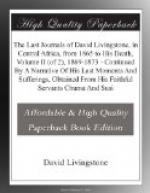Patience is all I can exercise: these irritable ulcers hedge me in now, as did my attendants in June, but all will be for the best, for it is in Providence and not in me.
The watershed is between 700 and 800 miles long from west to east, or say from 22 deg. or 23 deg. to 34 deg. or 35 deg. East longitude. Parts of it are enormous sponges; in other parts innumerable rills unite into rivulets, which again form rivers—Lufira, for instance, has nine rivulets, and Lekulwe other nine. The convex surface of the rose of a garden watering-can is a tolerably apt similitude, as the rills do not spring off the face of it, and it is 700 miles across the circle; but in the numbers of rills coming out at different heights on the slope, there is a faint resemblance, and I can at present think of no other example.
I am a little thankful to old Nile for so hiding his head that all “theoretical discoverers” are left out in the cold. With all real explorers I have a hearty sympathy, and I have some regret at being obliged, in a manner compelled, to speak somewhat disparagingly of the opinions formed by my predecessors. The work of Speke and Grant is part of the history of this region, and since the discovery of the sources of the Nile was asserted so positively, it seems necessary to explain, not offensively, I hope, wherein their mistake lay, in making a somewhat similar claim. My opinions may yet be shown to be mistaken too, but at present I cannot conceive how. When Speke discovered Victoria Nyanza in 1858, he at once concluded that therein lay the sources of the Nile. His work after that was simply following a foregone conclusion, and as soon as he and Grant looked towards the Victoria Nyanza, they turned their backs on the Nile fountains; so every step of their splendid achievement of following the river down took them further and further away from the Caput Nili. When it was perceived that the little river that leaves the Nyanza, though they called it the White Nile, would not account for that great river, they might have gone west and found headwaters (as the Lualaba) to which it can bear no comparison. Taking their White Nile at 80 or 90 yards, or say 100 yards broad, the Lualaba, far south of the latitude of its point of departure, shows an average breadth of from 4000 to 6000 yards, and always deep.
Considering that more than sixteen hundred years have elapsed since Ptolemy put down the results of early explorers, and emperors, kings, philosophers—all the great men of antiquity in short longed to know the fountains whence flowed the famous river, and longed in vain—exploration does not seem to have been very becoming to the other sex either. Madame Tinne came further up the river than the centurions sent by Nero Caesar, and showed such indomitable pluck as to reflect honour on her race. I know nothing about her save what has appeared in the public papers, but taking her exploration along with what was done




